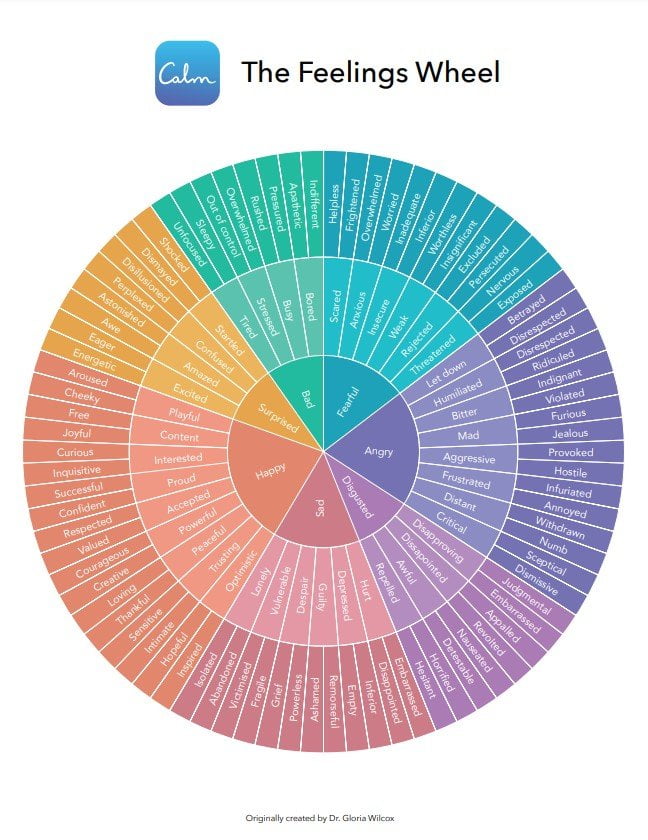Why It’s Okay to Not Be Happy All the Time
A friend recently wrote a Facebook post that began with, “Am I happy ALL the time? Short answer NO.” This got me thinking.
My friend then went on to share that she has become self-aware enough to know what makes her unhappy in life, and what she needs in life to “remain positive about the past, today, and the future.”
How profound is that? Self-awareness is an essential part of personal growth. And identifying your feelings is critical to maintaining personal balance.

In this article, I’d like to explore why it’s okay to not be happy all the time. Then, I’d like to ask some questions to help identify what you need in your life to be happy, and what makes you particularly unhappy. This will be a valuable personal growth activity for both of us.
It’s Okay to Not Be Happy All the Time
Did you know there are hundreds of emotions that you can feel on any given day? There are different levels of intensity and layers of emotions. And then when you throw midlife hormones into the mix, things can get crazy.
You can’t just ignore your feelings or push them away. There will naturally be times in life when you are not happy. There are events that make us sad; there are situations that make us anxious.
It’s all part of this journey we call LIFE. It’s unhealthy to ignore or push aside feelings that don’t feel good. We have to feel all the feels. Let’s find out why.

Why Feeling All Your Emotions Matters
For many of us, especially women in midlife and beyond, we’ve been conditioned to smile through the hard stuff—to keep going, stay positive, and not “dwell” on the messy emotions. I think it’s a generational thing.
But here’s the truth: Happiness isn’t a constant state, and it’s not the only emotion worth feeling.
This is where the Feelings Wheel comes in. Originally developed by Dr. Gloria Willcox in 1982, the Feelings Wheel helps us identify and name what we’re truly feeling—beyond just “happy,” “sad,” or “angry.”
The Feelings Wheel gives language to the rich emotional landscape that often gets oversimplified or ignored. It helps you take a deep dive into your emotions at any given moment.
“You don’t have to be positive all the time. It’s perfectly okay to feel sad, angry, annoyed, frustrated, scared, or anxious. Having feelings doesn’t make you a negative person—it makes you human.”
—Lori Deschene
When you take the time to acknowledge and label your emotions— whether it’s frustration, grief, excitement, jealousy, or peace—you invite self-awareness. And self-awareness is a cornerstone of personal growth.
Why is Naming Your Emotions Important?
…because pushing down uncomfortable emotions doesn’t make them go away.
It just buries them deeper. Then things get more complicated.
Over time, emotional suppression can show up as stress, burnout, anxiety, or even physical illness.
But when we honor our full emotional experience, we create space for healing, growth, and authentic joy—not the forced kind.
Don’t let anyone tell you that you are “too emotional.” You are human. And being human means experiencing the full spectrum of emotions—the highs, the lows, and everything in between. The Feelings Wheel will help you experience all your emotions.
I keep a magnetic Feelings Wheel on my fridge and reach for it every day. I have things going on in my life that are complicated. If I didn’t address my feelings, I would be a basket case.

How to Use the Feelings Wheel in Everyday Life
Using the Feelings Wheel doesn’t require a therapy session or a major life crisis. In fact, it works beautifully as a simple, mindful check-in— especially during those moments when you’re feeling “off” but can’t quite explain why.
Here’s how to start:
1. Pause and Notice
When you feel a strong emotion—or even a subtle one—give yourself a moment to pause. Ask: “What am I feeling right now?” Don’t rush to fix it or judge it. Just observe.
2. Use the Wheel to Dig Deeper
Start in the center of the wheel with a broad emotion like “sad,” “mad,” or “afraid.” Then follow the branches outward to find a more specific word that matches your experience—maybe it’s “disappointed,” “frustrated,” or “overwhelmed.”
The more precisely you name it, the more clarity you gain.
3. Validate What You Find
Whatever you discover—let it be valid. You don’t have to justify it or explain it away. Just acknowledging the feeling is powerful. Try saying, “I feel discouraged right now, and that’s okay.”
4. Reflect with Curiosity, Not Criticism
Ask yourself: “Why might I be feeling this? What do I need right now?” This isn’t about blame—it’s about compassion. This small act of reflection creates space for intentional responses instead of reactive ones.
For me, just seeing the words and being able to identify what I’m feeling helps me validate that it’s okay to not be happy all the time. Sometimes I even have a few different feelings happening at the same time, and the wheel helps me figure things out.

Embracing Emotions as a Path to Personal Growth
When you begin to name and sit with your emotions—instead of hiding from them—you’re doing powerful inner work.
This is the heart of personal growth—learning to understand yourself, not just change yourself.
Every emotion, even the uncomfortable ones, carries a message. Sadness may signal a loss that needs grieving.
“Happiness is not a constant state. It’s okay to have bad days, to feel off, to simply be.”
—Unknown
Anger might be pointing to a boundary that’s been crossed. Joy reminds you what lights you up. And fear? It often shows you what matters deeply to you.
By tuning in, you become more emotionally resilient. That doesn’t mean you’re happy all the time—it means you’re strong enough to feel it all and still move forward with intention and grace.
Especially in midlife, when so much is shifting—roles, identity, priorities—this emotional awareness becomes a superpower. It helps you respond to life’s challenges with clarity instead of chaos.
It strengthens your relationships, deepens your self-trust, and gives you permission to be beautifully, authentically you.
You don’t need to “fix” every emotion. You just need to feel them. That’s where healing lives. That’s where growth begins.
Using the Feelings Wheel for Journaling
Journaling with the Feelings Wheel is a gentle way to slow down and connect with your inner world. Try this simple practice:
- Choose a feeling from the wheel that reflects how you’re currently feeling or how you felt earlier today.
- Write the word at the top of the page, then free-write for a few minutes. Ask yourself:
- What triggered this feeling?
- Where do I feel it in my body?
- What might this emotion be trying to tell me?
- What do I need right now?
- Close your entry with compassion—even if the emotion is tough. Try something like, “I honor this feeling and trust that it’s here for a reason.”
Over time, this kind of reflection helps you recognize emotional patterns, release pent-up energy, deepen your self-awareness, and strengthen your personal growth.

The Next Steps: What Do You Need?
After working with the Feelings Wheel for a while, you’ll begin to notice something powerful—greater self-awareness. And with that awareness often comes a sense of calm—in both your mind and your body.
Giving yourself permission to feel all of your emotions is a deeply empowering act. It’s also a step closer to understanding what you truly need in your life—not just to get by, but to thrive.
I’m not talking about a good movie or a nice dinner kind of happy (though those are lovely, too!). I mean the big picture kind of happy. The soul-deep kind. The kind that comes from knowing yourself—and honoring what you need.
When you understand what makes you feel drained, disconnected, or discouraged, you can begin to work around those things.
And when you fill your days with more of what lights you up? That’s when the shift happens. That’s when more of your days begin to feel like your kind of happy.
As part of your personal growth, take some time to reflect on these questions:
- What kind of day brings me joy?
- What do I need in my life to feel my best?
- What kind of spaces help me feel calm or inspired?
- What makes me feel absolutely miserable?
- What kind of people do I avoid — and why?
- Who or what depletes my energy?
- What kind of schedule works best for me?
- Who do I enjoy spending time with?
- What or who energizes me?
- What or who makes me laugh and smile the most?
- What makes me feel “blah”?
- What makes me feel ecstatic?
Reflect on your answers with compassion and curiosity—not judgment. And then take a moment to recognize just how far you’ve come.
You’ve embraced the truth that it’s okay to not be happy all the time— and even more, you’ve discovered what you need to create more of those joyful, fulfilling, soul-nourishing days.
Yay for you. Truly.

Final Thoughts
You don’t have to chase happiness every second of the day. Real growth happens when you allow yourself to feel it all—the good, the hard, the in-between.
By exploring your emotions with tools like the Feelings Wheel, you’re not just navigating life—you’re actively growing through it.
So, give yourself grace. Keep listening inward. And remember, every emotion you feel is part of your beautiful, ever-evolving story.
You’ve got this, sister.
Related Articles:
- 21+ Ways to Practice Emotional Self Care and Wellness
- How to Respond When Someone Says You’re Too Sensitive
Love to ALL! ~ Susan







